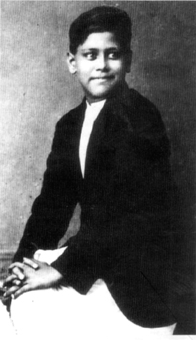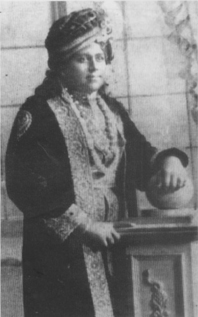|
He was acnowledged as the Nataka Chakravarti, or Emperor of the Stage, in an era when music was king, queen and courtier. His dramatic singing was recognised as the high point of the musical values of the Tamil theatrical renaissance. Such was the power of his song that even the common man developed an ear for classical music. His on-stage and off-stage romance with his adoring partner, the inimitable K.B. Sundarambal, set a million hearts aflame in the Tamil-speaking world – from Madurai and Kumbakonam to Colombo, Rangoon and Singapore. His sudden and sad passing away made Sundarambal don sackcloth and ashes with the pledge that she would act with no other male partner, a pledge that she kept for the next half century of her life.

The young Kittappa.
S.G. Kittappa has been all but forgotten by the Establishment down the decades. His birth centenary in 2006 did not excite as much as a whisper. The ‘Lion of Shencottah’ is an almost forgotten man even in his home town. Had he not got over his antipathy to the gramophone in the last few years of his life and recorded some sixty songs, and had his friend and admirer, the freedom-fighter and Gandhian, Aakkoor Ananthachari, not recorded the highlights of his career, the life and exploits of this vocal Pied Piper might have been the stuff of old wives’ tales.
It was on the afternoon of December 2, 1933 that a bed-ridden Kittappa covered his face with his hands and turned away from the world forever after battling the ravages of alcoholism. The mikeless times of Kittappa’s dramatic days, when men had to sing like sopranos to reach audiences at the end of the North Pole, are now truly history. The energy, exhilaration and effortless mastery that Kittappa brought to a song have still not been equalled or excelled. And when the listener left the confines of the gramophone record for the living moments of the stage, Kittappa was magic.
* * *
According to legend, after bathing in the Tamraparani, eight-year-old Kittappa (named Ramakrishnan, he had been called Bongappa and Kittan till he universally became Kittappa) had worshipped with his brothers at the beautiful Kurukkuthurai Murugan temple situated in the middle of the river on a rock known as Tiruvuruvamalai. Suddenly, he swooned and fainted. Kittappa’s brothers were agitated, but the priest was confident that the boy had had a vision. Kittappa soon regained consciousness. According to him, he had just completed singing a Tamil hymn on Murugan when he felt that the deity was calling him. “I am not aware what happened,” he said. This experience would have been brushed aside if it had not marked a new musical flowering. Before the Kurukkuthurai experience, the young Kittappa indeed sang sweetly, but his singing had limitations, his musically talented elder brothers noticed. After the swooning incident, some unseen inner springs seemed to have opened for Kittappa. Rich and nuanced ragas like Todi and Saveri burst forth from him in all their abundant splendour. Murugan indeed seemed to have opened His treasures to this boy, for those who met Kittappa have had experience of his ‘divine’ dimension. Sundarambal herself at her first meeting with him would speak of him as a gandharva. The cognoscenti looked upon him as an incomparable musical titan.
Alwarkurichi, in the Ambasamudram taluk of Tirunelveli District, was the village of Kittappa’s ancestors. In the 1830s, Kailasa Iyer was a pious man who owned a small piece of land near the fertile village. He found the stars favouring him through his wife Subbulakshmi of Shencottah. Suryanarayana Iyer, his father-in-law, was a rich man and Kailasa Iyer settled in his wife’s village. The couple had four children, the second being Gangadhara Iyer (1856), Kittappa’s father. A few years after his marriage, Gangadhara Iyer’s parents died, and very quickly he lost all his inherited wealth, thanks to his so-called friends.

Kittappa the actor.
The brood of children in the family stood at a lordly ten with Kittappa being, born on August 25, 1906. Gangadhara Iyer had begun to write the accounts of a landowner, but earned hardly enough to keep the wolf from the door. Two of his sons, Subbaiah and Chellappa, had to beg from door to door for food. Very soon they would join boys’ companies, professional drama troupes consisting almost wholly of boy actors who could sing. They were the ultimate refuge for poor but talented boys for half a century from the last two decades of the 19th Century and, at the same time, a protest movement against the general indiscipline and wanton lifestyle of senior actors. The salary of 18 rupees a month the boys earned was the first step towards showing them the way out from utter penury for the family.
Gangadhara Iyer accompanied his two elder sons as they toured with their drama company and Kittappa travelled with him. The family had no means to send Kittappa to school. When he was five, Kittappa’s real education began. He was all ears as the troupe’s director, Vadyar Sankaradas Swamigal, a seminal personality of the Tamil stage, taught his elder brothers to sing and speak dialogue, watching them intently as they acted on stage.
Uncannily alive to the talent of children, Sankardas Swamigal had the six-year old Kittappa first sing a prayer song in a play in Madura. Thereafter, Kittappa sang a variety of prayer songs. One day, when he acted in the play, Ali Badusha, as a tragic Muslim king’s pathetic son begging in the streets of a strange town, Kittappa’s soulful singing in the role wrung the hearts of the audience who flung gold and currency on to the stage. A similar role in the folk tragedy Nallathangal also had the audience in tears. Kittappa seemed to have been made for the stage and Sankaradas had set off another exciting career on its magnificent course.
With Kittappa their vanguard, the brothers struck it out on their own. At six years of age, Kittappa took Singapore by storm and acted there for months. This was followed by a whirlwind tour of South India and Ceylon. Colombo was to play a vital part in Kittappa’s life; he would later meet his heartthrob Sundarambal there and pair, to mesmerising effect, with her on stage for the first time in that city.
* * *
Enter C. Kannaiah Naidu – a minor stage actor who had gone broke running a drama company and was finally said to have been inspired in a dream by Andal, the saint poetess, to stage plays on Hindu themes. His Chennai Hindu Vinoda Naadaga Sabha staged plays like Dasavataram, Sri Krishna Leela, Sri Andal Tirukkalyanam and Sri Ramanuja Vaibhavam, all vehicles of the spectacular in Tamil drama.
When Kittappa joined him, he alone was projected in posters and drama notices, while the rest was relegated to the background. Kittappa’s musical dimension swung these visual extravaganzas to celestial heights. Imagine the histrionics needed for a male to portray Andal and carry a full-length play on his shoulders! Kittappa seems to have pulled it off effortlessly. People went to these plays as they would troop to temple festivals, camped in the vicinity of the theatres (or what passed for them), and waited for days to get tickets.
(To be concluded)
|

